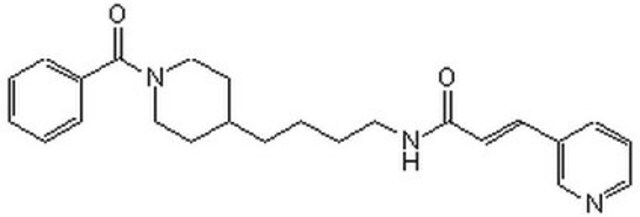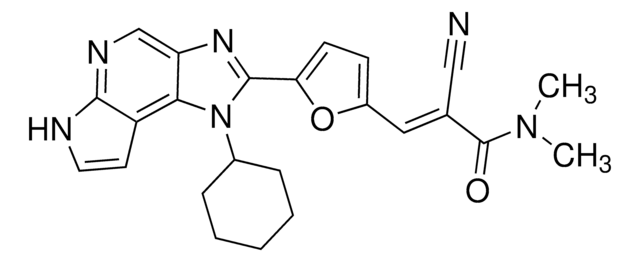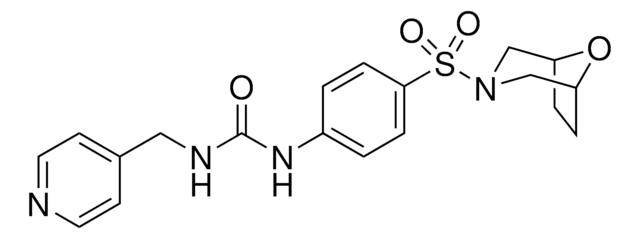すべての画像(1)
About This Item
実験式(ヒル表記法):
C21H18Br2N2O
CAS番号:
分子量:
474.19
MDL番号:
UNSPSCコード:
12352203
PubChem Substance ID:
NACRES:
NA.25
おすすめの製品
アッセイ
≥98% (HPLC)
形状
powder
色
white to off-white
溶解性
DMSO: 34 mg/mL
保管温度
2-8°C
SMILES記法
OC(CNc1ccccc1)Cn2c3ccc(Br)cc3c4cc(Br)ccc24
InChI
1S/C21H18Br2N2O/c22-14-6-8-20-18(10-14)19-11-15(23)7-9-21(19)25(20)13-17(26)12-24-16-4-2-1-3-5-16/h1-11,17,24,26H,12-13H2
InChI Key
FZHHRERIIVOATI-UHFFFAOYSA-N
アプリケーション
P7C3 is an aminopropyl carbazole agent with proneurogenic and neuroprotective properties in newborn neural precursor cells of the dentate gyrus. Its analogs may be used in neurodegenerative disease research to study the process of neurogenesis in brain regions such as the subgranular zone of the hippocampal dentate gyrus. P7C3 and its analogs may be used to study its pharmacokinetics, metabolism, safety, efficacy and methods of delivery as potential drug for the treatment of condition such as Alzheimer′s disease, Parkinson′s disease, amyotrophic lateral sclerosis and traumatic brain injury.
生物化学的/生理学的作用
P7C3は、神経原性を示し、新しいニューロンをアポトーシスから保護します。このような活性は、ミトコンドリア完全性を保護する能力に関係しているものと考えられます。
海馬の変性は、アルツハイマー病の初期徴候です。P7C3は、成体哺乳類の正常なニューロン新生部位である海馬歯状回の顆粒細胞下帯でニューロン新生を促進することから、アルツハイマー病の新たな治療法の開発において、重要なリード化合物となっています。
海馬の変性は、アルツハイマー病の初期徴候です。P7C3は、成体哺乳類の正常なニューロン新生部位である海馬歯状回の顆粒細胞下帯でニューロン新生を促進することから、アルツハイマー病の新たな治療法の開発において、重要なリード化合物となっています。
シグナルワード
Danger
危険有害性情報
危険有害性の分類
Acute Tox. 3 Oral - Eye Dam. 1
保管分類コード
6.1C - Combustible acute toxic Cat.3 / toxic compounds or compounds which causing chronic effects
WGK
WGK 3
引火点(°F)
Not applicable
引火点(℃)
Not applicable
適用法令
試験研究用途を考慮した関連法令を主に挙げております。化学物質以外については、一部の情報のみ提供しています。 製品を安全かつ合法的に使用することは、使用者の義務です。最新情報により修正される場合があります。WEBの反映には時間を要することがあるため、適宜SDSをご参照ください。
Jan Code
D8446-VAR:
D8446-BULK:
D8446-25MG:
D8446-5MG:
試験成績書(COA)
製品のロット番号・バッチ番号を入力して、試験成績書(COA) を検索できます。ロット番号・バッチ番号は、製品ラベルに「Lot」または「Batch」に続いて記載されています。
Hidehiro Oku et al.
Japanese journal of ophthalmology, 61(2), 195-203 (2016-12-30)
To determine whether P7C3-A20, a proneurogenic neuroprotective agent, can protect the retinal ganglion cells (RGCs) of rats from optic nerve crushing. The left optic nerve of 67 rats was crushed, and 5.0 mg/kg/day of P7C3-A20 (crush-P7C3) or its vehicle (crush-placebo) was
Rachel Tesla et al.
Proceedings of the National Academy of Sciences of the United States of America, 109(42), 17016-17021 (2012-10-03)
We previously reported the discovery of P7C3, an aminopropyl carbazole having proneurogenic and neuroprotective properties in newborn neural precursor cells of the hippocampal dentate gyrus. We have further found that chemicals having efficacy in this in vivo screening assay also
A K Walker et al.
Molecular psychiatry, 20(4), 500-508 (2014-04-23)
Augmenting hippocampal neurogenesis represents a potential new strategy for treating depression. Here we test this possibility by comparing hippocampal neurogenesis in depression-prone ghrelin receptor (Ghsr)-null mice to that in wild-type littermates and by determining the antidepressant efficacy of the P7C3
Chao Gu et al.
Frontiers in cellular neuroscience, 12, 400-400 (2018-11-21)
Parkinson's disease (PD) is the second most common neurodegenerative disorder. Although its pathogenesis remains unclear, growing evidencce suggests that microglia-mediated neuroinflammation contributes greatly to the progression of PD. P7C3, an aminopropyl carbazole, possesses significant neuroprotective effects in several neurodegenerative disease
Sudip Mondal et al.
ACS chemical neuroscience, 9(5), 1014-1026 (2018-02-11)
The nematode Caenorhabditis elegans, with tractable genetics and a well-defined nervous system, provides a unique whole-animal model system to identify novel drug targets and therapies for neurodegenerative diseases. Large-scale drug or target screens in models that recapitulate the subtle age-
ライフサイエンス、有機合成、材料科学、クロマトグラフィー、分析など、あらゆる分野の研究に経験のあるメンバーがおります。.
製品に関するお問い合わせはこちら(テクニカルサービス)










